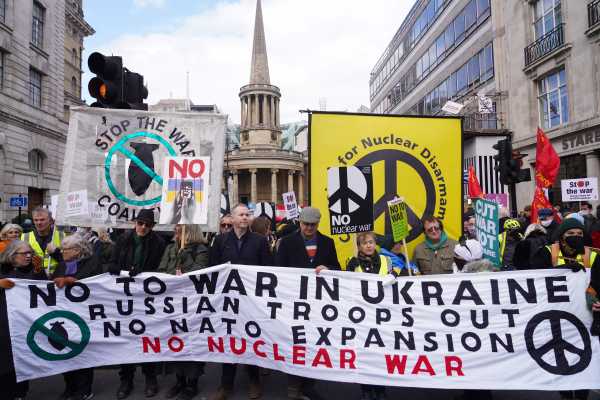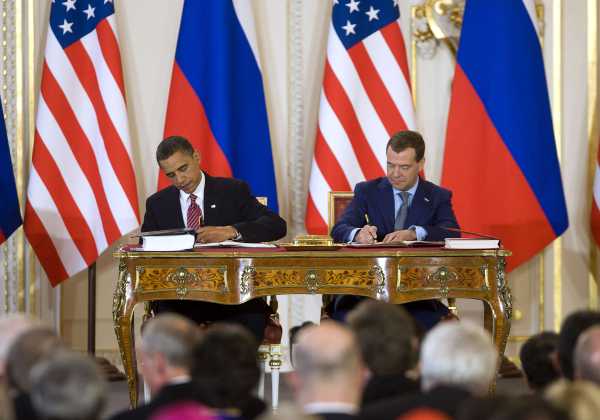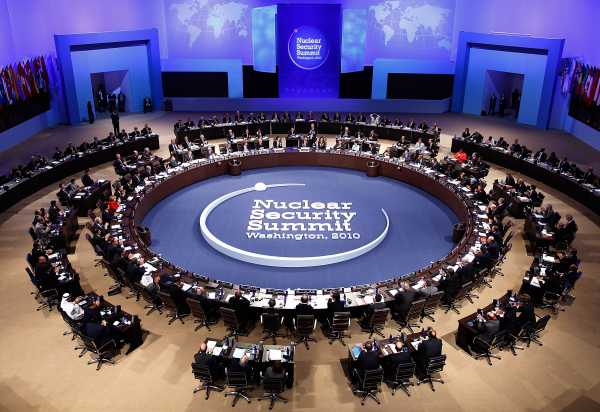
The Ukraine war has been devastating enough for civilians in that country, but it also carries the seeds of a graver global threat. Russian President Vladimir Putin has been rather explicitly threatening to escalate to using nuclear arms, particularly if Western countries get in his way.
President Joe Biden has sought to reassure Americans that a nuclear exchange is unlikely. He’s probably right. But the cost of such a war — we’re talking about a potential extinction-level event here, though the chances of outright extinction have declined somewhat as nuclear arsenals have shrunk — makes preventing it incredibly important, and means that even a seemingly small risk of nuclear war could be much, much too high. A recent simulation by Princeton’s Program on Science and Global Security suggests a total of 34.1 million immediate deaths in the first hours of a US-Russia exchange.
Alan Robock, an environmental scientist who studies what a nuclear war could do to the climate, told my colleague Alex Ward in 2018 that the most devastating effects of a nuclear war would actually come from the smoke, dust, and particulates produced by the explosions, leading to a nuclear autumn or winter. In the worst-case scenario, Robock said, “almost everybody on the planet would die.” Even using very conservative estimates, nuclear war winds up looking like a major cause of death worth investing considerable resources to prevent.
So what are people — and in particular philanthropists outside of government — investing in to prevent nuclear war? Not that much, given the scale of the potential catastrophe — and in the midst of one of the most alarming nuclear crises in years, the total is shrinking. “It’s a drop in the bucket compared to the other high-profile issues like climate change,” Emma Belcher, president of the Ploughshares Fund, one of the few dedicated funders on nuclear issues, told me.
It wasn’t always this way. Foundations and other donors have played a central role in efforts to contain nuclear weapons since the dawn of the atomic age, supporting conferences of US and Soviet scientists starting in the 1950s, the nuclear freeze movement of the 1980s, and the dismantling of nukes in post-Soviet states in the 1990s. They helped make nuclear issues a major public topic of debate — in 1982, some 750,000 people demonstrated in Central Park for nuclear disarmament, part of a foundation-supported anti-nuclear war movement.
Despite that past success, funding nuclear war prevention has always been hard, and it remains so today. It’s hard to know whether specific efforts are succeeding, and thus hard for funders to know if their spending is effective. But given the scale of the problem, and its relative neglectedness, there’s a solid argument that philanthropists should get serious again about reducing the risk of a nuclear war.
What nuclear funding actually funds
Before we dig too deep into the particulars of how nuclear issues are funded, let’s address an obvious question: How, exactly, can philanthropic funding reduce the risk of nuclear war?
Sometimes, there’s a role for philanthropies and their grantees in providing actual, physical services. Joan Rohlfing, president and chief operating officer of the Nuclear Threat Initiative (NTI), told me that NTI helped set up the International Atomic Energy Agency’s (IAEA) Low Enriched Uranium Bank in Kazakhstan. That’s a facility where non-nuclear powers can acquire uranium for nuclear power plants without being tempted to build their own enrichment facilities, which could be used to help produce weapons. A third of the facility’s funding came from NTI, which is in turn funded largely by foundations and individuals.
It’s a worthwhile program, but it is better suited to preventing nuclear terrorism or proliferation to non-nuclear states than it is to managing conflict between nuclear powers, like the US and Russia, that already have plenty of fissile material for bombs.
In heated political battles, like that over the Iran nuclear deal in 2015 or the ratification of the New START nuclear reduction treaty between the US and Russia in 2010, philanthropies can provide support by supporting advocacy targeting the public, Congress, and other stakeholders. Rose Gottemoeller, who was the Obama administration’s chief negotiator on the New START treaty, credits in her memoir foundation-funded advocacy groups with helping its ratification, writing that they “did important work to generate the campaign that began to inundate Senate offices with cards and letters.”

Going further back, philanthropic support played a big role in supporting the nuclear disarmament and nuclear freeze movements during the Cold War. The famous Pugwash Conferences, which gathered American, Soviet/Russian, and scientists of other nationalities to discuss nuclear risks and press for disarmament, were named after the town of Pugwash, Nova Scotia, the hometown of their funder Cyrus Eaton.
Funders can also support “Track II” talks between former officials in different countries on nuclear issues. These officials often cycle back into their respective governments, and Track II talks allow them to build rapport and relationships with each other. They can also (as in the past cases of Iran and North Korea) open a channel to talk indirectly to regimes the US is not yet directly negotiating with.
NTI helps convene a group known as the Euro-Atlantic Security Leadership Group, which Rohlfing described to me as a “Track 1.5” process because it includes both current and ex-government officials. Experts from the US, Russia, Canada, and various European countries can discuss and develop proposals to reduce nuclear risk. In the wake of the Ukraine war, the group, which includes Putin’s former foreign minister Igor Ivanov, issued a statement urging a ceasefire to prevent nuclear escalation.
But the most basic function of funding is to develop expertise in think tanks, academia, and blends of the two (e.g., Harvard’s Project on Managing the Atom) that can inform current policymakers and educate future policymakers. Robert Gallucci, the chief negotiator for the short-lived 1994 deal in which North Korea agreed not to develop nuclear weapons, and a key funder of nuclear groups as president of the MacArthur Foundation from 2009 to 2014, explained that one of his goals as a grantmaker was to train generations of scholars and practitioners who might influence or even write the Nuclear Posture Review (NPR), a congressionally mandated document released every few years that updates US nuclear policy.
At MacArthur, Gallucci recalls, “we picked schools like King’s College London, the JFK School, Princeton. … We were intent on growing the analysts and funding those kinds of programs so people would continue to talk about this, and we just wouldn’t get the old school writing the [Nuclear Posture Review].”
You can see some of the fruits of those efforts in the people tasked with overseeing nuclear policy, especially in Democratic administrations. Gottemoeller, one of Obama’s top nuclear staffers, came to the administration from the Carnegie Moscow Center, which relies on philanthropic support. Bonnie Jenkins, Biden’s undersecretary of state for arms control and international security, worked for years at the Harvard Project on Managing the Atom. Philanthropic support gave them space to learn and develop their views before (and after) government service.
Where is the money?
Funding for all of the above exists — but it’s relatively modest.
The Peace and Security Funders Group, an organization of foundations and other philanthropic funders, estimates that in 2020 about $47.7 million in grants were made globally on nuclear issues, excluding those made by the US federal government (which gave about $80.2 million between the Energy Department, the National Institutes of Health, and other agencies). $47.7 million might be an overestimate of the private contribution; it includes, for instance, funding going to the Nuclear Threat Initiative to work on biological risks like Covid-19, not just nuclear war.
When it comes to averting a threat with the potential to kill billions, $47.7 million a year just isn’t very much. And the pool is shrinking. Experts in the field told me there’s been a long decline in support since the end of the Cold War. Then, last year, the MacArthur Foundation (famous for its “genius grants”) announced that it was going to transition away from nuclear issues.
That decision hit the nuclear community like a punch in the gut. In 2018, before the change, 45 percent of all funding for nuclear issues came from MacArthur. That means funding could drop by nearly half with MacArthur’s ultimate exit in 2023. And this isn’t the first such shock the nuclear community has faced: The Hewlett Foundation poured $24.7 million into its Nuclear Security Initiative from 2007 to 2015 before exiting the field.

The MacArthur announcement also came shortly after the nuclear research group N Square released a major report built out of interviews with 72 nuclear threat reduction practitioners in Washington, DC. Its conclusions were bracing. Interviewees described a field dominated by figures (mostly white men) toward the end of their working lives, where progress early in a practitioner’s career was difficult; where different organizations don’t work effectively with each other; where compensation lagged relative to other fields; and where an “intensely critical and sometimes biting culture” could feel toxic and push good people away.
“The fact that MacArthur decided to pull out of the field and that the N Square report came out around the same time was kind of a come-to-Jesus moment for the nukes field,” Alexandra Toma, executive director of Peace and Security Funders Group, told me.
MacArthur made its decision after it commissioned and released an 80-page evaluation of its programs from the consulting firm ORS Impact (which declined to comment for this article). MacArthur’s “Nuclear Challenges” strategy focused on reducing, or at least slowing, production of “weapons useable material” like highly enriched uranium and plutonium. The ORS Impact report recited a variety of positive outcomes from MacArthur’s investments, including advancing policy developments in the US government and keeping dialogue channels open.
Ultimately, though, the report concluded that MacArthur’s goals — including “progress toward the long-term outcome of a negotiated” agreement to cease production and eliminate stockpiles of fissile materials, and a “strengthened nuclear regime by 2025” — were not in reach. “A line of sight” toward those outcomes, the report concluded, “is not discernible.” Shortly after the report, MacArthur announced it would make $30 million in “capstone” grants to nuclear organizations before exiting the field entirely in 2023.
“In 2015, we began our Nuclear Challenges Big Bet with the goal to end production and eliminate the stockpiles of weapons-useable material,” the foundation’s Maria Speiser said in an email. “In this case, data from multiple sources, including grantees and experts, indicated that the Foundation’s investments and the opportunities afforded by the external landscape did not offer a line-of-sight to our ultimate Big Bet goal.”
Nuclear funding post-MacArthur
While MacArthur has, as Inside Philanthropy’s Liz Longley notes, been funding nuclear programs since 1984, it reconceptualized a number of its programs in 2014 around the idea of “big bets,” which would be pursued through quick, big bursts of funding. The first two big bets announced in then-president Julia Stasch’s 2014 annual letter were “Climate Solutions” and “Safety and Justice Challenge” — the latter related to criminal justice in the US. The Nuclear Challenges bet was announced in 2016. In pivoting to this strategy, the foundation announced it was exiting a number of topics completely, including juvenile justice, housing, and population/reproductive health.
In the context of that strategy, it makes some sense that it would conclude one of those bets didn’t pay off and should be ended. Then again, the idea that the needle on nuclear safety could have been moved dramatically in the mere five years from the Nuclear Challenges bet announcement to its cancellation strikes me as absurd.
Reading the ORS Impact report on MacArthur, I found it … bizarre. It repeatedly seemed to blame the MacArthur strategy for not overcoming structural forces that one foundation could never overcome. “There has been degradation of treaties, agreements, and norms that are aligned with and uphold the nuclear regime,” the report notes — but at the same time, it notes that degradation is almost exclusively the result of the Trump administration’s decision to walk away from important nuclear agreements, like the Intermediate-Range Nuclear Forces Treaty (INF) and the Iran deal. MacArthur’s nuclear strategy may not have been perfect, but blaming the foundation for failing to avert the election of Donald Trump seems more than a little unfair.
Merely looking at the present nuclear policy regime and concluding it’s unsatisfactory, notes Gallucci, the former MacArthur president, is not sufficient analysis. You have to ask, as well, “what would happen if we hadn’t made the investment,” he says.
MacArthur is based in Chicago, Gallucci notes, and has been trying to lower the murder rate there for years. Murder is still high in Chicago — the number of homicides in 2021 hit the highest level in at least a quarter-century — but that doesn’t mean it’s wrong for MacArthur to try to address the problem. Perhaps the murder rate would’ve been even worse without MacArthur’s investments. “The big foundations, I think, should be expected to take on big problems where you don’t see easy wins, when you don’t see opportunities to take credit for impact,” Gallucci concludes. Nuclear issues are a paradigmatic case. You don’t get credit for the nuclear war that doesn’t happen.
And interventions against nuclear war are inherently harder to evaluate than interventions against relatively common phenomena, like homicides in Chicago. The city saw 836 homicides in 2021, meaning it has a quantitative target, the murder rate, that policymakers and philanthropists can try to reduce. Too much focus on these stats can have unintended consequences, but at least there’s some guidepost for success.

But absent any philanthropic intervention, the likely number of nuclear strikes in a given year is zero. With intervention, the likely number is zero. There just isn’t a quantitative indicator that can tell funders and grantees how well they’re doing, so inherently more subjective qualitative methods are necessary.
One option, Belcher of the Ploughshares Fund notes, is “process tracing”: “You can do interviews with government officials to determine what influences their thinking and where they got those ideas from.” This is imperfect (self-reports aren’t always reliable), but it does suggest that philanthropic investments can be productive.
The Nuclear Threat Initiative’s Rohlfing gives the example of the Cooperative Threat Reduction Program, formerly known as “Nunn-Lugar” after its Senate sponsors, which provided funding to dismantle nuclear weapons in former Soviet states like Ukraine and Kazakhstan. The program “emerged from Carnegie Corporation funding of Harvard to do a study on looking at how to denuclearize the former nuclear states after the Soviet Union dissolved,” she recalled. It has been, she concludes, “perhaps the single most important investment in the reduction of thousands of nuclear weapons over the following several decades.”
One hopeful sign: New groups are funding nuclear
So what comes next? One positive sign is the increased interest among donors affiliated with effective altruism in viewing nuclear war as an existential risk that could severely damage or even end human civilization. The Open Philanthropy Project and Good Ventures, which are largely funded by donors Cari Tuna and Dustin Moskovitz, have recently offered some funding for research into food production after a large-scale nuclear exchange, and into what a nuclear exchange would do to the climate.
Longview Philanthropy, an effective altruist-inspired grantmaking group in the UK, has also gotten engaged in nuclear issues. Carl Robichaud, a longtime nuclear grantmaker at the Carnegie Corporation, is currently an adviser to Longview and told me he’s joining full-time later this year. “I’m hopeful because what I see at Longview is a team that really understands the long-term importance of this issue as a potential catastrophic risk that affects everyone alive today, and the generations to come,” Robichaud told me.
It will be as hard for Open Philanthropy and Longview to evaluate the effectiveness of their interventions as it has been for any nuclear funder since the weapons’ invention. And some suspicion is of course warranted when nuclear groups tell you they need more funding. They’re not neutral parties.
But the Ukraine conflict should underline the fact that the threat of nuclear war did not end with the Cold War. It remains very real, and escalates as US-Russian relations get worse. Some more funding to prevent a world war may not be the worst thing in the world.
Will you support Vox’s explanatory journalism?
Millions turn to Vox to understand what’s happening in the news. Our mission has never been more vital than it is in this moment: to empower through understanding. Financial contributions from our readers are a critical part of supporting our resource-intensive work and help us keep our journalism free for all. Please consider making a contribution to Vox today.
Sourse: vox.com






